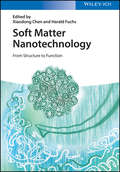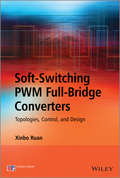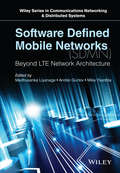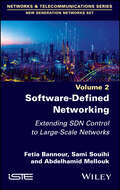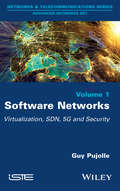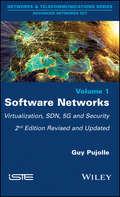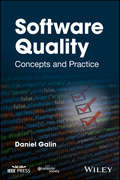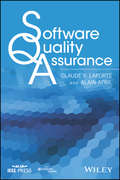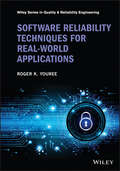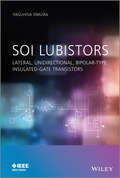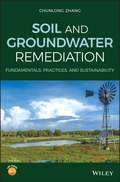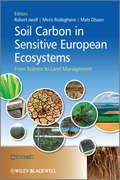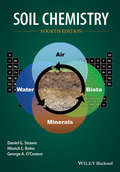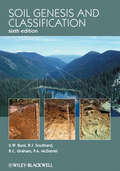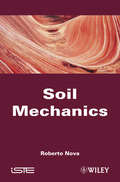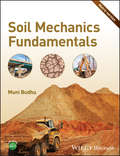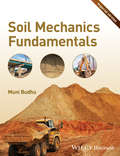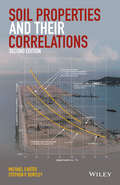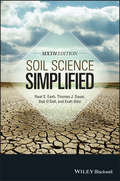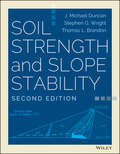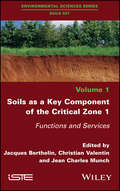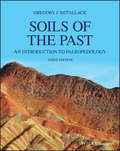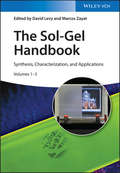- Table View
- List View
Soft Matter Nanotechnology
by Xiaodong Chen Harald FuchsUsing the well-honed tools of nanotechnology, this book presents breakthrough results in soft matter research, benefitting from the synergies between the chemistry, physics, biology, materials science, and engineering communities. The team of international authors delves beyond mere structure-making and places the emphasis firmly on imparting functionality to soft nanomaterials with a focus on devices and applications. Alongside reviewing the current level of knowledge, they also put forward novel ideas to foster research and development in such expanding fields as nanobiotechnology and nanomedicine. As such, the book covers DNA-induced nanoparticle assembly, nanostructured substrates for circulating tumor cell capturing, and organic nano field effect transistors, as well as advanced dynamic gels and self-healing electronic nanodevices. With its interdisciplinary approach this book gives readers a complete picture of nanotechnology with soft matter.
Soft-Switching PWM Full-Bridge Converters: Topologies, Control, and Design
by Xinbo RuanSoft-switching PWM full-bridge converters have been widely used in medium-to-high power dc-dc conversions for topological simplicity, easy control and high efficiency. Early works on soft-switching PWM full-bridge converter by many researchers included various topologies and modulation strategies. However, these works were scattered, and the relationship among these topologies and modulation strategies had not been revealed. This book intends to describe systematically the soft-switching techniques for pulse-width modulation (PWM) full-bridge converters, including the topologies, control and design, and it reveals the relationship among the various topologies and PWM strategies previously proposed by other researchers. The book not only presents theoretical analysis, but also gives many detailed design examples of the converters.
Software Defined Mobile Networks (SDMN)
by Andrei Gurtov Madhusanka Liyanage Mika YlianttilaThis book describes the concept of a Software Defined Mobile Network (SDMN), which will impact the network architecture of current LTE (3GPP) networks. SDN will also open up new opportunities for traffic, resource and mobility management, as well as impose new challenges on network security. Therefore, the book addresses the main affected areas such as traffic, resource and mobility management, virtualized traffics transportation, network management, network security and techno economic concepts. Moreover, a complete introduction to SDN and SDMN concepts. Furthermore, the reader will be introduced to cutting-edge knowledge in areas such as network virtualization, as well as SDN concepts relevant to next generation mobile networks. Finally, by the end of the book the reader will be familiar with the feasibility and opportunities of SDMN concepts, and will be able to evaluate the limits of performance and scalability of these new technologies while applying them to mobile broadband networks.
Software-Defined Networking: Extending SDN Control to Large-Scale Networks
by Fetia Bannour Sami Souihi Abdelhamid Mellouk<p>This book reviews the concept of Software-Defined Networking (SDN) by studying the SDN architecture. It provides a detailed analysis of state-of-the-art distributed SDN controller platforms by assessing their advantages and drawbacks and classifying them in novel ways according to various criteria.<p> <p>Additionally, a thorough examination of the major challenges of existing distributed SDN controllers is provided along with insights into emerging and future trends in that area.<p> <p>Decentralization challenges in large-scale networks are tackled using three novel approaches, applied to the SDN control plane presented in the book. The first approach addresses the SDN controller placement optimization problem in large-scale IoT-like networks by proposing novel scalability and reliability aware controller placement strategies. The second and third approaches tackle the knowledge sharing problem between the distributed controllers by suggesting adaptive multilevel consistency models following the concept of continuous Quorum-based consistency. These approaches have been validated using different SDN applications, developed from real-world SDN controllers.<p>
Software Networks
by Guy PujolleThe goal of this book is to describe new concepts for Internet next generation. This architecture is based on virtual networking using Cloud and datacenters facilities. Main problems concern 1) the placement of virtual resources for opening a new network on the fly, and 2) the urbanisation of virtual resource implemented on physical network equipment. This architecture deals with mechanisms capable of controlling automatically the placement of all virtual resources within the physical network. In this book, we describe how to create and delete virtual networks on the fly. Indeed, the system is able to create any new network with any kind of resource (e.g., virtual switch, virtual routers, virtual LSRs, virtual optical path, virtual firewall, virtual SIP-based servers, virtual devices, virtual servers, virtual access points, and so on). We will show how this architecture is compatible with new advances in SDN (Software Defined Networking), new high-speed transport protocol like TRILL (Transparent Interconnection of Lots of Links) and LISP (Locator/Identifier Separation Protocol), NGN, IMS, Wi-Fi new generation, and 4G/5G networks. Finally, we introduce the Cloud of security and the virtualisation of secure elements (smartcard) that should definitely transform how to secure the Internet.
Software Networks: Virtualization, SDN, 5G, and Security
by Guy PujolleSoftware Networks describe new concepts for the Internet's next generation. This architecture is based on virtual networking using Cloud and datacenter facilities. The main problems to be dealt with are the placement of virtual resources for opening a new network on the fly, and the urbanization of virtual resources implemented on physical network equipment. The digital architecture also deals with mechanisms capable of automatically controlling the placement of all virtual resources within the physical network. This book describes how to create and delete virtual networks on the fly. Indeed, the system is able to create any new network with any kind of virtual resource (e.g. switches, routers, LSRs, optical paths, firewalls, SIP-based servers, devices, servers, access points, etc.). Software Networks shows how this architecture is compatible with new advances in SDN (Software Defined Networking), new high-speed transport protocols such as TRILL (Transparent Interconnection of Lots of Links) and LISP (Locator/Identifier Separation Protocol), NGN, IMS, new generation Wi-Fi, and 4G/5G networks. Finally, the author introduces Clouds of security and the virtualization of secure elements (smartcards) that could certainly transform how to secure the Internet. For this second edition, the author addresses in five new chapters the importance of open source software for networks, mobile edge computing, fog networking, tactile internet – a network environment allowing remote access, and security – the use of Cloud of security, secure elements and the emergence of the blockchain.
Software Quality: Concepts and Practice
by Daniel GalinThe book presents a comprehensive discussion on software quality issues and software quality assurance (SQA) principles and practices, and lays special emphasis on implementing and managing SQA. Primarily designed to serve three audiences; universities and college students, vocational training participants, and software engineers and software development managers, the book may be applicable to all personnel engaged in a software projects Features: A broad view of SQA. The book delves into SQA issues, going beyond the classic boundaries of custom-made software development to also cover in-house software development, subcontractors, and readymade software. An up-to-date wide-range coverage of SQA and SQA related topics. Providing comprehensive coverage on multifarious SQA subjects, including topics, hardly explored till in SQA texts. A systematic presentation of the SQA function and its tasks: establishing the SQA processes, planning, coordinating, follow-up, review and evaluation of SQA processes. Focus on SQA implementation issues. Specialized chapter sections, examples, implementation tips, and topics for discussion. Pedagogical support: Each chapter includes a real-life mini case study, examples, a summary, selected bibliography, review questions and topics for discussion. The book is also supported by an Instructor’s Guide.
Software Quality Assurance
by Claude Y. Laporte Alain AprilThis book introduces Software Quality Assurance (SQA) and provides an overview of standards used to implement SQA. It defines ways to assess the effectiveness of how one approaches software quality across key industry sectors such as telecommunications, transport, defense, and aerospace. Includes supplementary website with an instructor’s guide and solutions Applies IEEE software standards as well as the Capability Maturity Model Integration for Development (CMMI) Illustrates the application of software quality assurance practices through the use of practical examples, quotes from experts, and tips from the authors
Software Reliability Techniques for Real-World Applications (Quality and Reliability Engineering Series)
by Roger K. YoureeSOFTWARE RELIABILITY TECHNIQUES FOR REAL-WORLD APPLICATIONS SOFTWARE RELIABILITY TECHNIQUES FOR REAL-WORLD APPLICATIONS Authoritative resource providing step-by-step guidance for producing reliable software to be tailored for specific projects Software Reliability Techniques for Real-World Applications is a practical, up to date, go-to source that can be referenced repeatedly to efficiently prevent software defects, find and correct defects if they occur, and create a higher level of confidence in software products. From content development to software support and maintenance, the author creates a depiction of each phase in a project such as design and coding, operation and maintenance, management, product production, and concept development and describes the activities and products needed for each. Software Reliability Techniques for Real-World Applications introduces clear ways to understand each process of software reliability and explains how it can be managed effectively and reliably. The book is supported by a plethora of detailed examples and systematic approaches, covering analogies between hardware and software reliability to ensure a clear understanding. Overall, this book helps readers create a higher level of confidence in software products. In Software Reliability Techniques for Real-World Applications, readers will find specific information on: Defects, including where defects enter the project system, effects, detection, and causes of defects, and how to handle defects Project phases, including concept development and planning, requirements and interfaces, design and coding, and integration, verification, and validation Roadmap and practical guidelines, including at the start of a project, as a member of an organization, and how to handle troubled projects Techniques, including an introduction to techniques in general, plus techniques by organization (systems engineering, software, and reliability engineering) Software Reliability Techniques for Real-World Applications is a practical text on software reliability, providing over sixty-five different techniques and step-by-step guidance for producing reliable software. It is an essential and complete resource on the subject for software developers, software maintainers, and producers of software.
SOI Lubistors: Lateral, Unidirectional, Bipolar-type Insulated-gate Transistors (Wiley - IEEE)
by Yasuhisa OmuraAdvanced level consolidation of the technology, physics and design aspects of silicon-on-insulator (SOI) lubistors No comprehensive description of the physics and possible applications of the Lubistor can be found in a single source even though the Lubistor is already being used in SOI LSIs. The book provides, for the first time, a comprehensive understanding of the physics of the Lubistor. The author argues that a clear understanding of the fundamental physics of the pn junction is essential to allowing scientists and engineers to propose new devices. Since 2001 IBM has been applying the Lubistor to commercial SOI LSIs (large scale integrated devices) used in PCs and game machines. It is a key device in that it provides electrostatic protection to the LSIs. The book explains the device modeling for such applications, and covers the recent analog circuit application of the voltage reference circuit. The author also reviews the physics and the modeling of ideal and non-ideal pn junctions through reconsideration of the Shockley’s theory, offering readers an opportunity to study the physics of pn junction. Pn-junction devices are already applied to the optical communication system as the light emitter and the receiver. Alternatively, optical signal modulators are proposed for coupling the Si optical waveguide with the pn-junction injector. The book also explores the photonic crystal physics and device applications of the Lubistor. Advanced level consolidation of the technology, physics and design aspects of silicon-on-insulator (SOI) lubistors Written by the inventor of the Lubistor, this volume describes the technology for readers to understand the physics and applications of the device First book devoted to the Lubistor transistor, presently being utilized in electrostatic discharge (ESD) applications in SOI technology, a growing market for semiconductor devices and advanced technologies Approaches the topic in a systematic manner, from physical theory, through to modelling, and finally circuit applications This is an advanced level book requiring knowledge of electrical and electronics engineering at graduate level. Contents includes: Concept of Ideal pn Junction/Proposal of Lateral, Unidirectional, Bipolar-Type Insulated-Gate Transistor (Lubistor)/ Noise Characteristics and Modeling of Lubistor/Negative Conductance Properties in Extremely Thin SOI Lubistors/ Two-Dimensionally Confined Injection Phenomena at Low Temperatures in Sub-10-nm-Thick SOI Lubistors/ Experimental Study of Two-Dimensional Confinement Effects on Reverse-Biased Current Characteristics of Ultra-Thin SOI Lubistors/ Gate-Controlled Bipolar Action in Ultra-thin Dynamic Threshold SOI MOSFET/Sub-Circuit Models of SOI Lubistors for Electrostatic Discharge Protection Circuit Design and Their Applications/A New Basic Element for Neural Logic Functions and Functionality in Circuit Applications/Possible Implementation of SOI Lubistors into Conventional Logic Circuits/Potentiality of Electro-Optic Modulator Based on SOI Waveguide/Principles of Parameter Extraction/Feasibility of Lubistor-Based Avalanche Photo Transistor
Soil and Groundwater Remediation: Fundamentals, Practices, and Sustainability
by Chunlong ZhangAn introduction to the principles and practices of soil and groundwater remediation Soil and Groundwater Remediation offers a comprehensive and up-to-date review of the principles, practices, and concepts of sustainability of soil and groundwater remediation. The book starts with an overview of the importance of groundwater resource/quality, contaminant sources/types, and the scope of soil and groundwater remediation. It then provides the essential components of soil and groundwater remediation with easy-to-understand design equations/calculations and the practical applications. The book contains information on remediation basics such as subsurface chemical behaviors, soil and groundwater hydrology and characterization, regulations, cost analysis, and risk assessment. The author explores various conventional and innovative remediation technologies, including pump-and-treat, soil vapor extraction, bioremediation, incineration, thermally enhanced techniques, soil washing/flushing, and permeable reactive barriers. The book also examines the modeling of groundwater flow and contaminant transport in saturated and unsaturated zones. This important book: Presents the current challenges of remediation practices Includes up-to-date information about the low-cost, risk-based, sustainable remediation practices, as well as institutional control and management Offers a balanced mix of the principles, practices, and sustainable concepts in soil and groundwater remediation Contains learning objectives, discussions of key theories, and example problems Provides illustrative case studies and recent research when remediation techniques are introduced Written for undergraduate seniors and graduate students in natural resource, earth science, environmental science/engineering, and environmental management, Soil and Groundwater Remediation is an authoritative guide to the principles and components of soil and groundwater remediation that is filled with worked and practice problems.
Soil Carbon in Sensitive European Ecosystems
by Mats Olsson Robert Jandl Mirco RodeghieroSoil Carbon in Sensitive European Ecosystems - From Science to Land Management is a comprehensive overview of the latest research in this field drawn together by a network of scientists from across Europe. Soil carbon assessments are crucial at present to our understanding of the dynamics of terrestrial ecosystems and our ability to assess implications for the global carbon exchange and its consequences on the future climate. This book focuses primarily on ecosystems and their soil carbon stocks. The book identifies three key sensitive ecosystems within Europe: Mediterranean Forest and Agricultural Systems; Mountains; and Peatland.Contributors include those currently working for the European research programme, COST Action 639 BurnOut (www.cost639.net; 2006-2010).COST Action 639 emerged from a demand from policy makers in Europe for more detailed information on soil carbon dynamics. The cooperation between experts for reporting and experts for soil dynamics is the focus of the book. This book seeks to provide an up-to-date account on the state-of-the-art research within this topical field.
Soil Chemistry
by Daniel G. Strawn Hinrich L. Bohn George A. O'ConnorSoil is key to sustaining life—affecting air and water quality, the growth of plants and crops, and the health of the entire planet. Soil Chemistry 4e provides comprehensive coverage of the chemical interactions among organic and inorganic solids, air, water, microorganisms, and the plant roots in soil. The fourth edition of Soil Chemistry has been revised and updated throughout and provides a basic description of important research and fundamental knowledge in the field. The text covers chemical processes that occur in soils, including: distribution and species of nutrients and contaminants in soils; aqueous chemistry of soil solutions and mineral dissolution; oxidation and reduction reactions in soils; soil mineral formation processes and properties; the formation and reactivity of soil organic matter; surface chemistry and cation, anion, and organic compound adsorption reactions; modelling soil chemical reactions; and reactions in acid and salt affected soils. Although extensively revised with updated figures and tables, the fourth edition maintains the focus on introductory soil chemistry that has distinguished earlier editions. New chapters on properties of elements relevant to soil chemistry, and a chapter with special focus on soil surface characteristics have been added. Special Topics boxes are also included in the Fourth Edition that includes examples, noteworthy topics, and case studies. End of chapter questions are included as a resource for teaching.
Soil Chemistry
by Daniel G. Strawn Hinrich L. Bohn George A. O'ConnorProvides comprehensive coverage of the chemical interactions among organic and inorganic solids, air, water, microorganisms, and the plant roots in soil This book focuses on the species and reaction processes of chemicals in soils, with applications to environmental and agricultural issues. Topics range from discussion of fundamental chemical processes to review of properties and reactions of chemicals in the environment. This new edition contains more examples, more illustrations, more details of calculations, and reorganized material within the chapters, including nearly 100 new equations and 51 new figures. Each section also ends with an important concepts overview as well as new questions for readers to answer. Starting with an introduction to the subject, Soil Chemistry, 5th Edition offers in-depth coverage of properties of elements and molecules; characteristics of chemicals in soils; soil water chemistry; redox reactions in soils; mineralogy and weathering processes in soils; and chemistry of soil clays. The book also provides chapters that examine production and chemistry of soil organic matter; surface properties of soil colloids; adsorption processes in soils; measuring and predicting sorption processes in soils; soil acidity; and salt-affected soils. Provides a basic description of important research and fundamental knowledge in the field of soil chemistry Contains more than 200 references provided in figure and table captions and at the end of the chapters Extensively revised with updated figures and tables Soil Chemistry, 5th Edition is an excellent text for senior-level soil chemistry students.
Soil Genesis and Classification
by Stanley W. Buol Randal J. Southard Robert C. Graham Paul A. McDanielSoil Genesis and Classification, Sixth Edition, builds on the success of the previous editions to present an unparalleled resource on soil formation and classification. Featuring a color plate section containing multiple soil profiles, this text also includes information on new classification systems and emerging technologies and databases with updated references throughout. Covering the diverse needs of both the academic and professional communities, this classic text will be a must have reference for all those in soil science and related fields.
Soil Health Analysis, Set (ASA, CSSA, and SSSA Books)
by Douglas L. Karlen Diane E. Stott Maysoon M. MikhaVolume 1 briefly reviews selected &“Approaches to Soil Health Analysis&” including a brief history of the concept, challenges and opportunities, meta-data and assessment, applications to forestry and urban land reclamation, and future soil health monitoring and evaluation approaches.Volume 2 focuses on &“Laboratory Methods for Soil Health Analysis&” including an overview and suggested analytical approaches intended to provide meaningful, comparable data so that soil health can be used to guide restoration and protection of our global soil resources.
Soil Mechanics
by Roberto NovaKnowledge of the behavior of soil mechanics is essential for forecasting the internal displacements and actions of any construction. This book, although theoretical at first glance, also offers a more practical scope, giving readers adequate tools to plan geotechnical projects correctly.
Soil Mechanics Fundamentals
by Muniram BudhuAn accessible, clear, concise, and contemporary course in geotechnical engineering, this key text: strikes a balance between theory and practical applications for an introductory course in soil mechanics keeps mechanics to a minimum for the students to appreciate the background, assumptions and limitations of the theories discusses implications of the key ideas to provide students with an understanding of the context for their application gives a modern explanation of soil behaviour is presented particularly in soil settlement and soil strength offers substantial on-line resources to support teaching and learning
Soil Mechanics Fundamentals
by Muniram BudhuThis accessible, clear and concise textbook strikes a balance between theory and practical applications for an introductory course in soil mechanics for undergraduates in civil engineering, construction, mining and geological engineering. Soil Mechanics Fundamentals lays a solid foundation on key principles of soil mechanics for application in later engineering courses as well as in engineering practice. With this textbook, students will learn how to conduct a site investigation, acquire an understanding of the physical and mechanical properties of soils and methods of determining them, and apply the knowledge gained to analyse and design earthworks, simple foundations, retaining walls and slopes. The author discusses and demonstrates contemporary ideas and methods of interpreting the physical and mechanical properties of soils for both fundamental knowledge and for practical applications. The chapter presentation and content is informed by modern theories of how students learn: Learning objectives inform students what knowledge and skills they are expected to gain from the chapter. Definitions of Key Terms are given which students may not have encountered previously, or may have been understood in a different context. Key Point summaries throughout emphasize the most important points in the material just read. Practical Examples give students an opportunity to see how the prior and current principles are integrated to solve ‘real world’ problems.
Soil Properties and their Correlations
by Stephen P. Bentley Michael CarterSoil Properties and their Correlations, Second Edition Michael Carter, Geotechnical Consultant (Retired), UK Stephen P Bentley, Reader in Engineering Geology, Cardiff University, UK An essential guide to improving preliminary geotechnical analysis and design from limited data Soil Properties and their Correlations, Second Edition provides a summary of commonly-used soil engineering properties and gives a wide range of correlations between the various properties, presented in the context of how they will be used in geotechnical design. The book is divided into 11 chapters: Commonly-measured properties; Grading and plasticity; Density; Permeability, Consolidation and settlement; Shear strength; California bearing ratio; Shrinkage and swelling characteristics; Frost susceptibility; Susceptibility to combustion; and Soil-structure interfaces. In addition, there are two appendices: Soil classification systems; and Sampling methods. This new, more comprehensive, edition provides material that would be of practical assistance to those faced with the problem of having to estimate soil behaviour from little or no laboratory test data. Key features: * Soil properties explained in practical terms. * A large number of correlations between different soil properties. * A valuable aid for assessing design values of properties. * Clear statements on practical limitations and accuracy. An invaluable source of reference for experienced professionals working on geotechnical design, it will also give students and early-career engineers an in-depth appreciation of the appropriate use of each property and the pitfalls to avoid.
Soil Science Simplified
by Aga Razvi Thomas J. Sauer Forbes Walker Neal EashAlready renowned as a user-friendly beginners' guide to soil science, Soil Science Simplified, 6th Edition is an updated version of the beloved textbook that includes even more thorough applications of soil science to interdisciplinary fields. It includes the most recent research concerning uses of soil in municipal, engineering, and other areas, conversion agriculture covering no-till, hoe-till, and the methodology of cover crops, crop rotations, N contribution, and worldwide trends in conversion agriculture. The experienced authors have fully revised and updated the fundamental chapters on physical, chemical, and biological properties to create an ideal introductory text.
Soil Strength and Slope Stability
by J. Michael Duncan Stephen G. Wright Thomas L. BrandonThe definitive guide to the critical issue of slope stability and safety Soil Strength and Slope Stability, Second Edition presents the latest thinking and techniques in the assessment of natural and man-made slopes, and the factors that cause them to survive or crumble. Using clear, concise language and practical examples, the book explains the practical aspects of geotechnical engineering as applied to slopes and embankments. The new second edition includes a thorough discussion on the use of analysis software, providing the background to understand what the software is doing, along with several methods of manual analysis that allow readers to verify software results. The book also includes a new case study about Hurricane Katrina failures at 17th Street and London Avenue Canal, plus additional case studies that frame the principles and techniques described. Slope stability is a critical element of geotechnical engineering, involved in virtually every civil engineering project, especially highway development. Soil Strength and Slope Stability fills the gap in industry literature by providing practical information on the subject without including extraneous theory that may distract from the application. This balanced approach provides clear guidance for professionals in the field, while remaining comprehensive enough for use as a graduate-level text. Topics include: Mechanics of soil and limit equilibrium procedures Analyzing slope stability, rapid drawdown, and partial consolidation Safety, reliability, and stability analyses Reinforced slopes, stabilization, and repair The book also describes examples and causes of slope failure and stability conditions for analysis, and includes an appendix of slope stability charts. Given how vital slope stability is to public safety, a comprehensive resource for analysis and practical action is a valuable tool. Soil Strength and Slope Stability is the definitive guide to the subject, proving useful both in the classroom and in the field.
Soils as a Key Component of the Critical Zone 1: Functions and Services
by Jacques Berthelin Christian Valentin Jean Charles MunchThis introductory book to the six volume series includes an introduction defining the critical zone for mankind that extends from tree canopy and the lower atmosphere to water table and unweathered rock. Soils play a crucial role through the functions and the services that they provide to mankind. The spatial and temporal variability of soils is represented by information systems whose importance, recent evolutions and increasingly performing applications in France and in the world must be underlined. The soil functions, discussed in this book, focus on the regulation of the water cycle, biophysicochemical cycles and the habitat role of biodiversity. The main services presented are those related to the provision of agricultural, fodder and forest products, energy, as well as materials and the role of soil as infrastructure support. They also include the different cultural dimensions of soils, their representations being often linked to myths and rites, as well as their values of environmental and archaeological records. Finally, the issue is raised of an off-ground world.
Soils of the Past: An Introduction to Paleopedology
by Gregory J. RetallackA student-friendly textbook that describes ancient soils, how they may be identified, and their use in paleoenvironmental reconstruction Ancient soils contain vital mineralogical, geochemical, textural, and paleontological information about the continental environments in which they formed. Advances in isotope geochemistry and sequence-stratigraphic models allow evermore detailed reconstructions of environmental change from paleosols, and new insights into such diverse topics as atmospheric chemistry, global change, paleoecology, geobiology and mass extinction. This book educates readers about the field of paleopedology and how it remains a key area of investigation for geologists and environmental scientists seeking to learn about, and reconstruct, the condition and evolution of paleoenvironments. Presented in three sections—Soils and Palesols; Factors in Soil Formation; and Fossil Record of Soils—Soils of the Past: An Introduction to Paleopedology describes the main types of ancient soil, procedures for identifying and studying them, their classification and, most significantly, a wide array of examples of how paleosols have been used for paleoenvironmental reconstruction. The book is an excellent reflection of the current state of knowledge and can be widely adopted over many disciplines. All chapters have been revised and updated to reflect advances in soil science in the last two decades New tables display a wealth of new data added since the 2nd edition published in 2001 New figures have been added and line art has been redrawn to improve clarity and promote understanding References have been updated throughout Soils of the Past, 3rd Edition is written for advanced undergraduates studying paleopedology as part of a degree in geology, environmental science, or physical geography, and for interested professional earth scientists.
The Sol-Gel Handbook
by Marcos Zayat David LevyThis comprehensive three-volume handbook brings together a review of the current state together with the latest developments in sol-gel technology to put forward new ideas. The first volume, dedicated to synthesis and shaping, gives an in-depth overview of the wet-chemical processes that constitute the core of the sol-gel method and presents the various pathways for the successful synthesis of inorganic and hybrid organic-inorganic materials, bio- and bio-inspired materials, powders, particles and fibers as well as sol-gel derived thin films, coatings and surfaces. The second volume deals with the mechanical, optical, electrical and magnetic properties of sol-gel derived materials and the methods for their characterization such as diffraction methods and nuclear magnetic resonance, infrared and Raman spectroscopies. The third volume concentrates on the various applications in the fields of membrane science, catalysis, energy research, biomaterials science, biomedicine, photonics and electronics.
